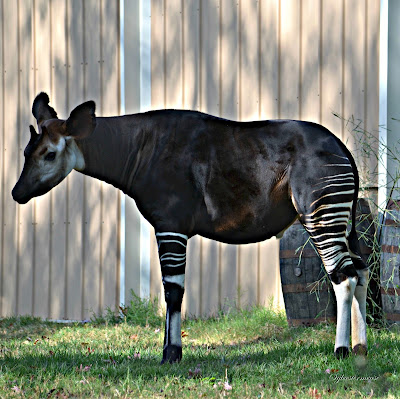The Okapi is related to the giraffe, but has stripes like a zebra. They are also closer in size to the zebra, but they share other unique characteristics with the giraffe.
You will want to make sure you visit the Okapi soon. Sadly, the Okapi are very rare and are endangered. They can only be found in the wild in the Democratic Republic of the Congo in Central Africa. Therefore, your very best chance to see an Okapi, is at a zoo. Even then, not every zoo has them.
The Okapi's Ossicone
Giraffes and Okapis are the only animals that have ossicones. At first glance, you would think the Okapi has horns. He does not. Male Okapi have ossicones on their heads. When you visit the Okapi, be sure to take a really close look at his head. You will notice that the ossicones are covered with skin and fur. That is completely different from horns, which are bare bone. What will not be as obvious in observation, is that the ossicone is made of flexible cartilage, not hard bone. This characteristic alone makes the Okapi quite unique.
Facts About the Okapi
- Okapia johnstoni
- Endangered
- Lives in the Rainforest of the African Congo
- Stripes on Hind Quarters and Legs
- Males have Ossicones (not horns)
- Females do not have ossicones. They have little swirls of hair instead
- Females are Larger than Males
- Weighs 400 - 750 lbs.
- Stand approximate 5' tall
- Coat is Dark Brown with Reddish hues
- Habitat: Dense Tropical Forest
- Food: Leaves, Twigs and Fruit
- Breeding: Single Offspring Birth
- Okapi hide their young
- Lifespan: 30 years
- Okapi were not known to science until 1900
Not Long Enough
Most likely due to their natural seclusion and avoidance of danger, the Okapi were not known to science until 1900. It is estimated that there are 10,000 - 20,000 Okapi worldwide. As with so many other beautiful creatures, the Okapi is now on the endangered list due to being hunted for their meat and skins.
Wild Republic Cuddlekin Okapi 12Check PriceThe Story of the Okapi (Fabulous Animals)Check PriceThe Okapi: Mysterious Animal of Congo-ZaireCheck Price
Note: The author may receive a commission from purchases made using links found in this article. “As an Amazon Associate I earn from qualifying purchases.”


No comments:
Post a Comment